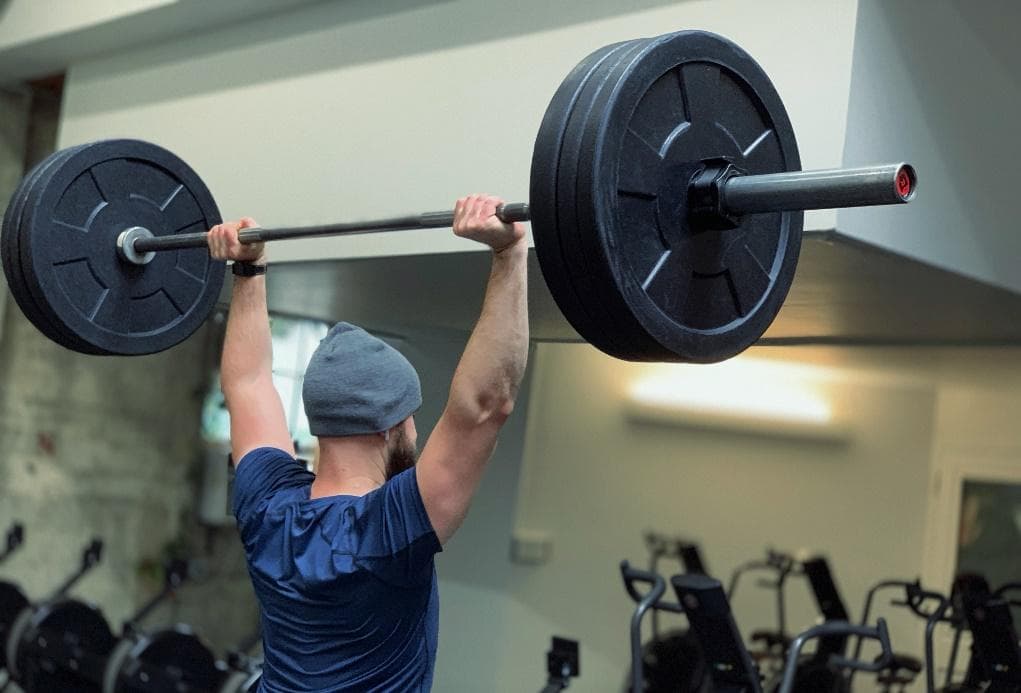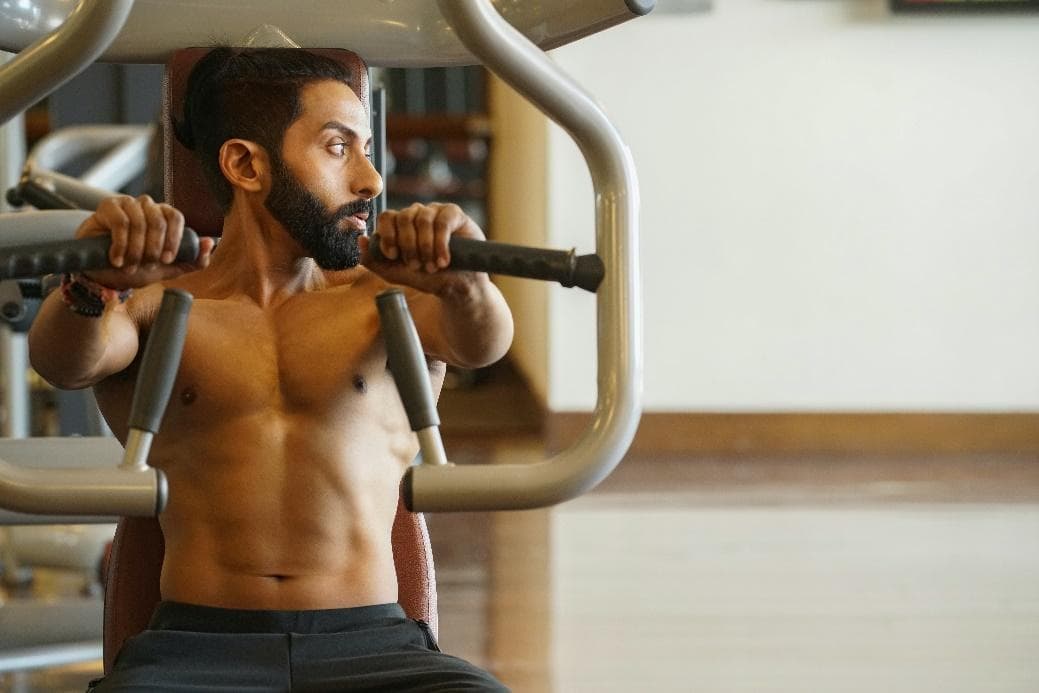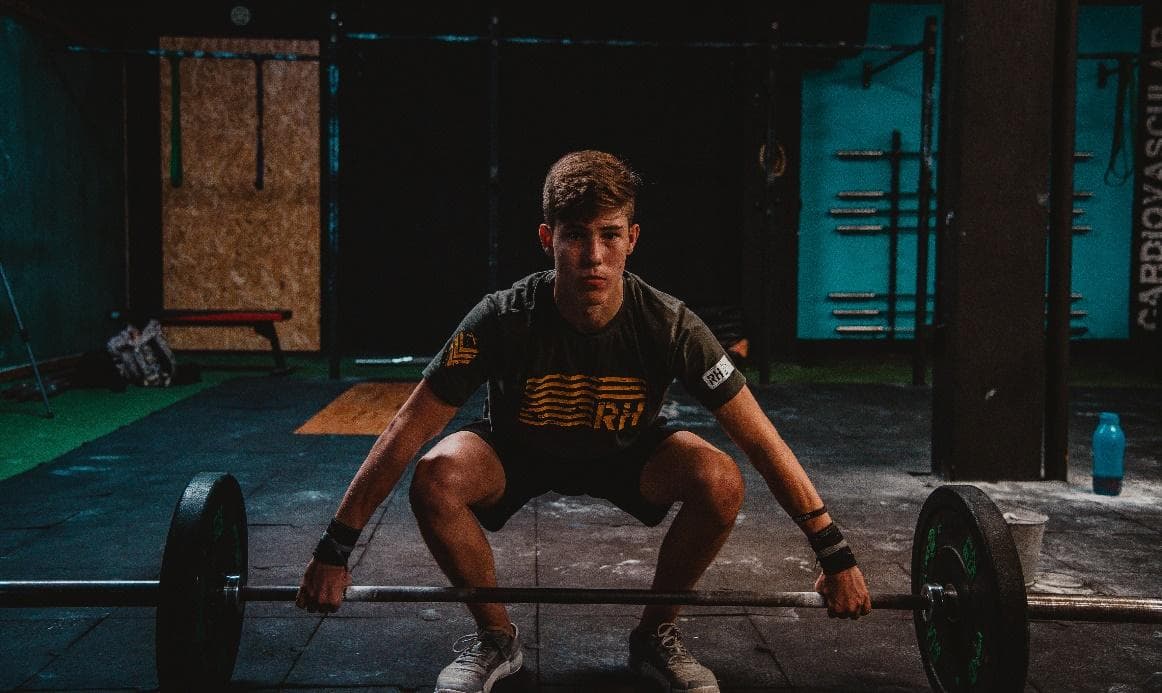13 de November de 2022
Should I Work Out with Sore Muscles?
Before you know if you should train with stiffness, what is it?

Image taken from Bruce Mars (Unsplash)
Delayed onset muscle soreness (DOMS) is a functional muscle disorder caused by eccentric muscle contractions or unknown forms of exercise (Hotfiel et al., 2018). By performing biopsies at the muscular level, it has been proven that there are ultrastructural lesions, including the transmission and widening of the Z band, which destroys the sarcomeres of the myofibrils (Leeder, Gissane, Van Someren, Gregson, & Howatson, 2012). Recent research points towards a strong involvement of associated connective tissue in delayed onset muscle soreness, which brings the focus more towards the fascia rather than towards the muscle itself (Wilke & Behringer, 2021).
One way or another, DOMS is one of the reasons why sports performance is compromised to a greater or lesser extent. Such stiffness can range from mild muscle soreness, which disappears with moderate activity, to pain and inability to perform certain movements (Ihsan, Watson, & Abbiss, 2016). Poor regulation of training and recovery can result a mild muscle overload or lead to more serious sports injuries, so it is preferable to rest a few days of training if we have stiffness, instead of missing more days due to a more intense muscle overload.
When does stiffness appear?
Delayed-onset muscle soreness (DOMS hereafter) can manifest itself early on, between six to twelve hours after exercise. From then they increase progressively until they reach a maximum level of soreness at 48h – 72h after exercise (Hotfiel et al., 2018). A few days after that maximum peak of stiffness, about the fifth to the seventh day after the end of the exercise that produced them, they disappear completely (Gregson et al., 2011).
Why does stiffness appear?
It’s common for people who perform strength training for the first time, however minimal it may be, to show stiffness that can become disabling. From not being able to get dressed without muscle pain, to having discomfort when getting up from the chair. However, people who are more advanced in strength need much more volume for DOMS to appear. The difference between beginners and advanced exercisers is that beginners are faced with an unfamiliar task, while advanced exercisers are already adapted to it. However, advanced strength people may experience stiffness after performing a task that is new to them, such as jogging down a hill or playing a game of paddle tennis.
Our skeletal muscle becomes inflamed during eccentric exercise and in the face of unfamiliar tasks that are going to involve more load than our muscle fibers are used to supporting (Heiss et al., 2019). It is common for them to appear after a session of rapid stretch-shortening cycles, such as running, changes of directions and jumping, as short and fast eccentric contractions occur. To check this out go to the top of your city and walk downhill for an hour. A couple of days later you will notice DOMS in the back of your legs with a high probability.
Should I train with muscle stiffness?

Image taken from Cyan Cooper (Unsplash)
For many years three mechanisms have been proposed that result in muscle mass gain: mechanical strain, metabolic stress and muscle damage (Schoenfeld, 2010). Years later, the same author, conducted an extensive review of the scientific literature to expose that there is no direct link between muscle mass gains and muscle damage (Schoenfeld, 2012). While it is true that eccentric exercise is an important part of gaining muscle mass, strength and preventing injury, it is not clear what degree of damage is optimal to produce adaptations (Schoenfeld & Contreras, 2013).
That fine line between stimulus and muscle damage is where the coach must program and the athlete must train. Evidence seems to show that there is a threshold beyond which muscle damage has more drawbacks than benefits (Schoenfeld, 2012). The reason is that excessive muscle damage can affect the athlete’s ability to train, which impairs performance. This is where one of my favorite phrases comes into play: stimulate, don’t damage. A quality workout will be one that produces maximum adaptations with minimum stimulus.
The general population often confuses stiffness with a great workout, but in reality, stiffness is a sign of poor load programming. Stiffness should not be used as an indicator of training results, i.e., the higher the DOMS, the more adaptations there are (Schoenfeld & Contreras, 2013). At an amateur level there is no major problem in resting a few extra days for overdoing it in training, but at advanced levels that can mean a loss of performance or, in the worst case, an injury. So, should I train with stiffness or not?
How much stiffness do you have?
On a scale of 1 to 10, how much stiffness do you have? That’s the first step to know if we can train with stiffness or not. DOMS is not black and white, it’s not one or ten, it can be three, six or nine. One system you can use is the four stiffness zones, depending on your sensations and ability to exert force (Paulsen, Mikkelsen, Raastad, & Peake, 2012):
- Zone 1: I have no soreness and can lift my usual training marks.
- Zone 2: I feel like I have trained and can move slightly less weight in training, but it is not significant.
- Zone 3: I feel like I have trained and the loads I usually lift are a little harder to move. I can train, but not to my 100%.
- Zone 4: I have a lot of stiffness and I can hardly move any weight.
Depending on our objective, we can spend more or less time during the season in one or another of these four zones. While muscle damage isn’t a good ally of strength, it can be a training partner to increase muscle mass (Schoenfeld, 2012; Schoenfeld & Contreras, 2013). In this way we can train with stiffness in some cases, depending on the training we are going to perform, but not in others. Based on the above four areas we will give a somewhat more concise answer to the question of whether we should train with stiffness.
Should I train with stiffness to gain muscle mass?

Image taken from Rohit Reddy (Unsplash)
Muscle mass gain is related, to some extent, to muscle damage since it requires eccentric contractions and muscle lengthening (Schoenfeld, 2012; Schoenfeld & Contreras, 2013). Zone 2 is the most interesting since it is the one when we notice muscle stiffness indicating that we have trained, but we can train practically at 100%. To this zone we would give half of the volume, that is, 50% of the workouts should be in this zone.
Zone 4 is the red line that we should only pass at specific times of the season when we are looking for a shock stimulus, but we shouldn’t give it more than 10% of the annual volume. Between zone 2 and zone 4 we have zone 3 in which we can train, but with less intensity. The good news is that in order to gain muscle mass, volume is more important than intensity, so we can train in this zone 20% of the total volume of the year. The remaining 20% we will leave for zone 1 in those moments of unloading after periods of training attempts to use them as active rest.
Therefore, we can train with stiffness to gain muscle mass, although the ideal is that this stiffness, most of the time, is barely noticeable and allows us to train at 100%.
Should I train with stiffness to gain strength and power?

Image taken from Luis Vidal (Unsplash)
To become stronger, we don’t need muscle damage, except in mesocycles in which we seek an increase in muscle mass. Muscle mass gains will benefit from approaching muscle failure, and even reaching it. However, strength gains are produced without the need to reach muscle failure, or even get close to it (Grgic, Schoenfeld, Orazem, & Sabol, 2022). For this reason, the most interesting thing will be not to produce stiffness in strength training. To do this we must train taking care of the training variables and monitoring them with technology such as velocity measuring devices.
When we measure the velocity at which we move our load we can program with the highest quality the fatigue that will involve each series and session. As we do repetition, the velocity at which we move the load is decreasing, which is associated with fatigue (González-Badillo, Yañez-García, Mora-Custodio, & Rodríguez-Rosell, 2017). If we lose 20% of the velocity in the series, we produce less fatigue than if we continue doing repetitions until we lose 40% velocity (Pareja-Blanco et al., 2020). The greater the loss of velocity, the greater the fatigue and the greater the probability of stiffness. Following the association, the greater the stiffness, the lower the performance in the following session.
If our objective is to gain strength, we can’t train with stiffness as our performance will be lower, which will hinder our gains. Even more dangerous is the increased risk of injury that occurs if we train with stiffness. Imagine you go for heavy sets in deadlifts and you have stiffness in your legs, what can happen? When stretching our hamstrings with DOMS there is a high risk of injury to muscles such as the biceps femoris. Therefore, if we are looking to gain muscle strength or power you should not train with stiffness. It’s preferable that you rest until they are eliminated. This means that of the four zones discussed above, we should stay in zone 1 and zone 2, avoiding entering zone 3 and much less zone 4.
Effective methods to keep stiffness away
In high performance, stiffness isn’t welcome. That’s why effective strategies are sought to stop the onset of DOMS after intense training or demanding competition. There are three passive strategies that have some evidence of their usefulness: massages; compression garments; and cryotherapy (Dupuy, Douzi, Theurot, Bosquet, & Dugué, 2018). These techniques reduce muscle damage and exercise-induced inflammation. Another effective strategy, but in an active way, is the recovery that we have seen in tennis players such as Rafael Nadal who after several hours of matches get on the bike for about 20 minutes.
The goal is to accelerate the clearance of all the waste substances that have been produced with the competition or training (Ortiz, Sinclair Elder, Elder, & Dawes, 2019). That shows us that soreness isn’t a good friend of performance and that we should avoid it as much as possible. Remember: stimulate, don’t hurt. That’s the best way to program our sessions, since, although depending on the degree of stiffness we can train, the ideal is to avoid it if muscle soreness is too high. Firstly, to prevent injuries, and secondly, to avoid poor quality training sessions.
Joaquin Vico Plaza
Bibliographic references
Dupuy, O., Douzi, W., Theurot, D., Bosquet, L., & Dugué, B. (2018). An Evidence-Based Approach for Choosing Post-exercise Recovery Techniques to Reduce Markers of Muscle Damage, Soreness, Fatigue, and Inflammation: A Systematic Review With Meta-Analysis. Frontiers in Physiology, 9(APR). https://doi.org/10.3389/FPHYS.2018.00403
González-Badillo, J. J., Yañez-García, J. M., Mora-Custodio, R., & Rodríguez-Rosell, D. (2017). Velocity Loss as a Variable for Monitoring Resistance Exercise. International Journal of Sports Medicine, 38(3), 217–225. https://doi.org/10.1055/S-0042-120324
Gregson, W., Black, M. A., Jones, H., Milson, J., Morton, J., Dawson, B., … Green, D. J. (2011). Influence of cold water immersion on limb and cutaneous blood flow at rest. The American Journal of Sports Medicine, 39(6), 1316–1323. https://doi.org/10.1177/0363546510395497
Grgic, J., Schoenfeld, B. J., Orazem, J., & Sabol, F. (2022). Effects of resistance training performed to repetition failure or non-failure on muscular strength and hypertrophy: A systematic review and meta-analysis. Journal of Sport and Health Science, 11(2), 202–211. https://doi.org/10.1016/J.JSHS.2021.01.007
Heiss, R., Lutter, C., Freiwald, J., Hoppe, M. W., Grim, C., Poettgen, K., … Hotfiel, T. (2019). Advances in Delayed-Onset Muscle Soreness (DOMS) – Part II: Treatment and Prevention. Sportverletzung Sportschaden : Organ Der Gesellschaft Fur Orthopadisch-Traumatologische Sportmedizin, 33(1), 21–29. https://doi.org/10.1055/A-0810-3516
Hotfiel, T., Freiwald, J., Hoppe, M. W., Lutter, C., Forst, R., Grim, C., … Heiss, R. (2018). Advances in Delayed-Onset Muscle Soreness (DOMS): Part I: Pathogenesis and Diagnostics. Sportverletzung Sportschaden : Organ Der Gesellschaft Fur Orthopadisch-Traumatologische Sportmedizin, 32(4), 243–250. https://doi.org/10.1055/A-0753-1884
Ihsan, M., Watson, G., & Abbiss, C. R. (2016). What are the Physiological Mechanisms for Post-Exercise Cold Water Immersion in the Recovery from Prolonged Endurance and Intermittent Exercise? Sports Medicine (Auckland, N.Z.) , 46(8), 1095–1109. https://doi.org/10.1007/S40279-016-0483-3
Leeder, J., Gissane, C., Van Someren, K., Gregson, W., & Howatson, G. (2012). Cold water immersion and recovery from strenuous exercise: a meta-analysis. British Journal of Sports Medicine, 46(4), 233–240. https://doi.org/10.1136/BJSPORTS-2011-090061
Ortiz, R. O., Sinclair Elder, A. J., Elder, C. L., & Dawes, J. J. (2019). A Systematic Review on the Effectiveness of Active Recovery Interventions on Athletic Performance of Professional-, Collegiate-, and Competitive-Level Adult Athletes. Journal of Strength and Conditioning Research, 33(8), 2275–2287. https://doi.org/10.1519/JSC.0000000000002589
Pareja-Blanco, F., Alcazar, J., Sánchez-Valdepeñas, J., Cornejo-Daza, P. J., Piqueras-Sanchiz, F., Mora-Vela, R., … Alegre, L. M. (2020). Velocity Loss as a Critical Variable Determining the Adaptations to Strength Training. Medicine and Science in Sports and Exercise, 52(8), 1752–1762. https://doi.org/10.1249/MSS.0000000000002295
Paulsen, G., Mikkelsen, U. R., Raastad, T., & Peake, J. (2012). Leucocytes, cytokines and satellite cells: what role do they play in muscle damage and regeneration following eccentric exercise? Exercise Immunology Review.
Schoenfeld, B. J. (2010). The mechanisms of muscle hypertrophy and their application to resistance training. Journal of Strength and Conditioning Research, 24(10), 2857–2872. https://doi.org/10.1519/JSC.0B013E3181E840F3
Schoenfeld, B. J. (2012). Does exercise-induced muscle damage play a role in skeletal muscle hypertrophy? Journal of Strength and Conditioning Research, 26(5), 1441–1453. https://doi.org/10.1519/JSC.0B013E31824F207E
Schoenfeld, B. J., & Contreras, B. (2013). Is postexercise muscle soreness a valid indicator of muscular adaptations? Strength and Conditioning Journal, 35(5), 16–21. https://doi.org/10.1519/SSC.0B013E3182A61820
Wilke, J., & Behringer, M. (2021). Is “Delayed Onset Muscle Soreness” a False Friend? The Potential Implication of the Fascial Connective Tissue in Post-Exercise Discomfort. International Journal of Molecular Sciences, 22(17). https://doi.org/10.3390/IJMS22179482

